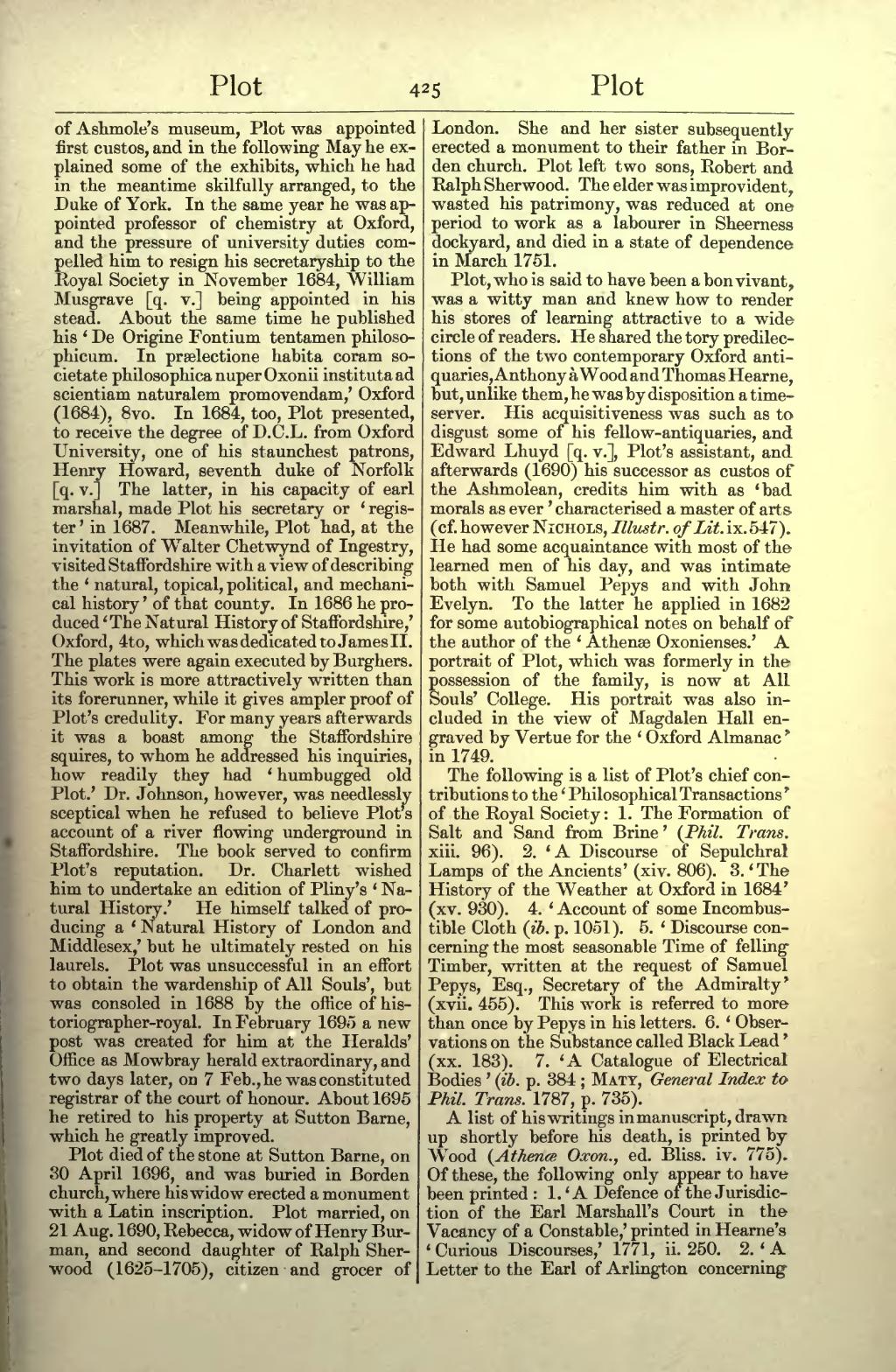of Ashmole's museum, Plot was appointed first custos, and in the following May he explained some of the exhibits, which he had in the meantime skilfully arranged, to the Duke of York. In the same year he was appointed professor of chemistry at Oxford, and the pressure of university duties compelled him to resign his secretaryship to the Royal Society in November 1684, William Musgrave [q. v.] being appointed in his stead. About the same time he published his ‘De Origine Fontium tentamen philosophicum. In prælectione habita coram societate philosophica nuper Oxonii instituta ad scientiam naturalem promovendam,’ Oxford (1684), 8vo. In 1684, too, Plot presented, to receive the degree of D.C.L. from Oxford University, one of his staunchest patrons, Henry Howard, seventh duke of Norfolk [q. v.] The latter, in his capacity of earl marshal, made Plot his secretary or ‘register’ in 1687. Meanwhile, Plot had, at the invitation of Walter Chetwynd of Ingestry, visited Staffordshire with a view of describing the ‘natural, topical, political, and mechanical history’ of that county. In 1686 he produced ‘The Natural History of Staffordshire,’ Oxford, 4to, which was dedicated to James II. The plates were again executed by Burghers. This work is more attractively written than its forerunner, while it gives ampler proof of Plot's credulity. For many years afterwards it was a boast among the Staffordshire squires, to whom he addressed his inquiries, how readily they had ‘humbugged old Plot.’ Dr. Johnson, however, was needlessly sceptical when he refused to believe Plot's account of a river flowing underground in Staffordshire. The book served to confirm Plot's reputation. Dr. Charlett wished him to undertake an edition of Pliny's ‘Natural History.’ He himself talked of producing a ‘Natural History of London and Middlesex,’ but he ultimately rested on his laurels. Plot was unsuccessful in an effort to obtain the wardenship of All Souls', but was consoled in 1688 by the office of historiographer-royal. In February 1695 a new post was created for him at the Heralds' Office as Mowbray herald extraordinary, and two days later, on 7 Feb., he was constituted registrar of the court of honour. About 1695 he retired to his property at Sutton Barne, which he greatly improved.
Plot died of the stone at Sutton Barne, on 30 April 1696, and was buried in Borden church, where his widow erected a monument with a Latin inscription. Plot married, on 21 Aug. 1690, Rebecca, widow of Henry Burman, and second daughter of Ralph Sherwood (1625–1705), citizen and grocer of London. She and her sister subsequently erected a monument to their father in Borden church. Plot left two sons, Robert and Ralph Sherwood. The elder was improvident, wasted his patrimony, was reduced at one period to work as a labourer in Sheerness dockyard, and died in a state of dependence in March 1751.
Plot, who is said to have been a bon vivant, was a witty man and knew how to render his stores of learning attractive to a wide circle of readers. He shared the tory predilections of the two contemporary Oxford antiquaries, Anthony à Wood and Thomas Hearne, but, unlike them, he was by disposition a time-server. His acquisitiveness was such as to disgust some of his fellow-antiquaries, and Edward Lhuyd [q. v.], Plot's assistant, and afterwards (1690) his successor as custos of the Ashmolean, credits him with as ‘bad morals as ever’ characterised a master of arts (cf. however Nichols, Illustr. of Lit. ix. 547). He had some acquaintance with most of the learned men of his day, and was intimate both with Samuel Pepys and with John Evelyn. To the latter he applied in 1682 for some autobiographical notes on behalf of the author of the ‘Athenæ Oxonienses.’ A portrait of Plot, which was formerly in the possession of the family, is now at All Souls' College. His portrait was also included in the view of Magdalen Hall engraved by Vertue for the ‘Oxford Almanac’ in 1749.
The following is a list of Plot's chief contributions to the ‘Philosophical Transactions’ of the Royal Society: 1. ‘The Formation of Salt and Sand from Brine’ (Phil. Trans. xiii. 96). 2. ‘A Discourse of Sepulchral Lamps of the Ancients’ (xiv. 806). 3. ‘The History of the Weather at Oxford in 1684’ (xv. 930). 4. ‘Account of some Incombustible Cloth’ (ib. p. 1051). 5. ‘Discourse concerning the most seasonable Time of felling Timber, written at the request of Samuel Pepys, Esq., Secretary of the Admiralty’ (xvii. 455). This work is referred to more than once by Pepys in his letters. 6. ‘Observations on the Substance called Black Lead’ (xx. 183). 7. ‘A Catalogue of Electrical Bodies’ (ib. p. 384; Maty, General Index to Phil. Trans. 1787, p. 735).
A list of his writings in manuscript, drawn up shortly before his death, is printed by Wood (Athenæ Oxon., ed. Bliss. iv. 775). Of these, the following only appear to have been printed: 1. ‘A Defence of the Jurisdiction of the Earl Marshall's Court in the Vacancy of a Constable,’ printed in Hearne's ‘Curious Discourses,’ 1771, ii. 250. 2. ‘A Letter to the Earl of Arlington concerning
